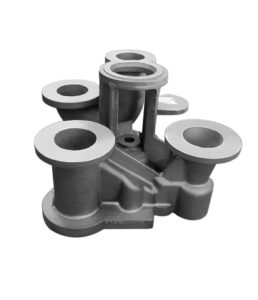Gestión de Compras has a wide experience designs, develops and manufactures a huge range of pieces for sand casting.
Process of Sand casting
Sand casting is a metalworking method which is widely used in casting process, as almost all metals can be sand casted. Its main characteristic is the use of expendable sand molds to form complex metal parts that can be made of nearly any alloy. This method typically has a low production rate because the sand mold must be destroyed in order to remove the part and it has a tendency to yield products with a comparatively rough surface finish.
Essentially, a mold is produced by shaping a refractory material to form a cavity of desired shape such that molten metal can be poured into the cavity. The mold cavity needs to retain its shape until the metal has solidified and the casting is removed.
Step 1
The process starts with a pattern, which is a replica of the finished part, except that it is slightly larger to allow for metal shrinkage during solidification and cooling. Then, a flask is placed around the pattern and sand is packed. Next, pressure is applied to the sand to compact firmly against the face of the pattern. When it is compacted, the sand mixture exhibits physical properties that allow it to hold the exact shape of the pattern after the pattern is drawn from the mold.
Step 2
The following step is placing the cores if any in the bottom half of the mold, the top section is set in place and the closed mold is then ready for pouring. When the material casting has solidified, the sand is removed and returned to storage for reconditioning for later use. An important and economical aspect of the sand casting process is that the sand can be reused many times with only small additions of new sand, clay and water.
Preparation of sand
There are different preparations of the sand for the mold, but the most widely used is Green Sand which typical composition is a mixture of sand (usually Silica sand), Bentonite clay, water, binders and, in some cases, anthracite. It is called “green” not by its color, but it denotes the presence of moisture in the molding sand and indicates that the mold is not baked or dried. The molds made with this sand are the least expensive ones.
Tolerances
Lineal allowance for small dimensions (up to 200 mm) on parts made by sand casting is difficult reduce under ±0.5 mm but in each additional millimetre only add 0.01 mm to uncertainties. It’s possible reduce these tolerances by machining operations.
This process have a typical surface finish is about 10 micrometres.
Standard and certificates
Our factories have the most demanding certifications for customers to ensure product quality as:
- ISO9001, TS16949 and ISO 14001.
- QS9000, AS9100
- DINEN 12890
Surface quality:
UNE 4766
Tolerances:
ISO 8062:2013
ISO 286-2
ANSI B4.1
UNE 2768, UNE 1697
Others




